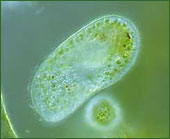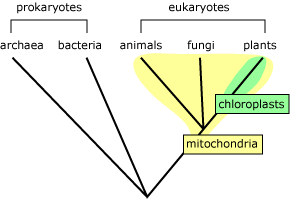Biologist Lynn Margulis first made the case for endosymbiosis in the 1960s, but for many years other biologists were skeptical. Although Jeon watched his amoebae become infected with the x-bacteria and then evolve to depend upon them, no one was around over a billion years ago to observe the events of endosymbiosis. Why should we think that a mitochondrion used to be a free-living organism in its own right? It turns out that many lines of evidence support this idea. Most important are the many striking similarities between prokaryotes (like bacteria) and mitochondria:
- Membranes — Mitochondria have their own cell membranes, just like a prokaryotic cell does.
- DNA — Each mitochondrion has its own circular DNA genome, like a bacteria’s genome, but much smaller. This DNA is passed from a mitochondrion to its offspring and is separate from the “host” cell’s genome in the nucleus.

- Reproduction — Mitochondria multiply by pinching in half — the same process used by bacteria. Every new mitochondrion must be produced from a parent mitochondrion in this way; if a cell’s mitochondria are removed, it can’t build new ones from scratch.

When you look at it this way, mitochondria really resemble tiny bacteria making their livings inside eukaryotic cells! Based on decades of accumulated evidence, the scientific community supports Margulis’s ideas: endosymbiosis is the best explanation for the evolution of the eukaryotic cell.
What’s more, the evidence for endosymbiosis applies not only to mitochondria, but to other cellular organelles as well. Chloroplasts are like tiny green factories within plant cells that help convert energy from sunlight into sugars, and they have many similarities to mitochondria. The evidence suggests that these chloroplast organelles were also once free-living bacteria.
The endosymbiotic event that generated mitochondria must have happened early in the history of eukaryotes, because all eukaryotes have them. Then, later, a similar event brought chloroplasts into some eukaryotic cells, creating the lineage that led to plants.
Despite their many similarities, mitochondria (and chloroplasts) aren’t free-living bacteria anymore. The first eukaryotic cell evolved more than a billion years ago. Since then, these organelles have become completely dependent on their host cells. For example, many of the key proteins needed by the mitochondrion are imported from the rest of the cell. Sometime during their long-standing relationship, the genes that code for these proteins were transferred from the mitochondrion to its host’s genome. Scientists consider this mixing of genomes to be the irreversible step at which the two independent organisms become a single individual.

Paramecium bursaria, a single-celled eukaryote that swims around in pond water, may not have its own chloroplasts, but it does manage to “borrow” them in a rather unusual way. P. bursaria swallows photosynthetic green algae, but it stores them instead of digesting them. In fact, the normally clear paramecium can pack so many algae into its body that it even looks green! When P. bursaria swims into the light, the algae photosynthesize sugar, and both cells share lunch on the go. But P. bursaria doesn’t exploit its algae. Not only does the agile paramecium chauffeur its algae into well-lit areas, it also shares the food it finds with its algae if they are forced to live in the dark.

